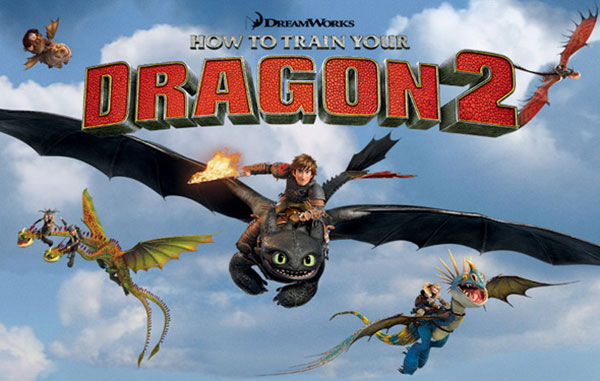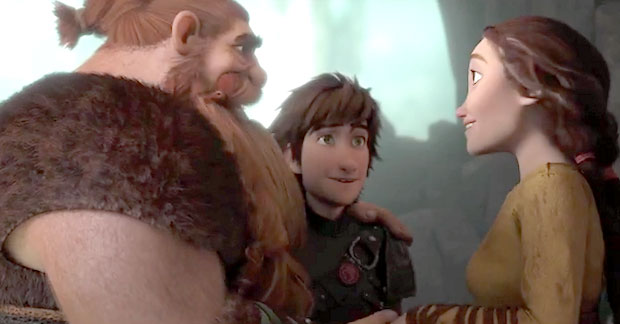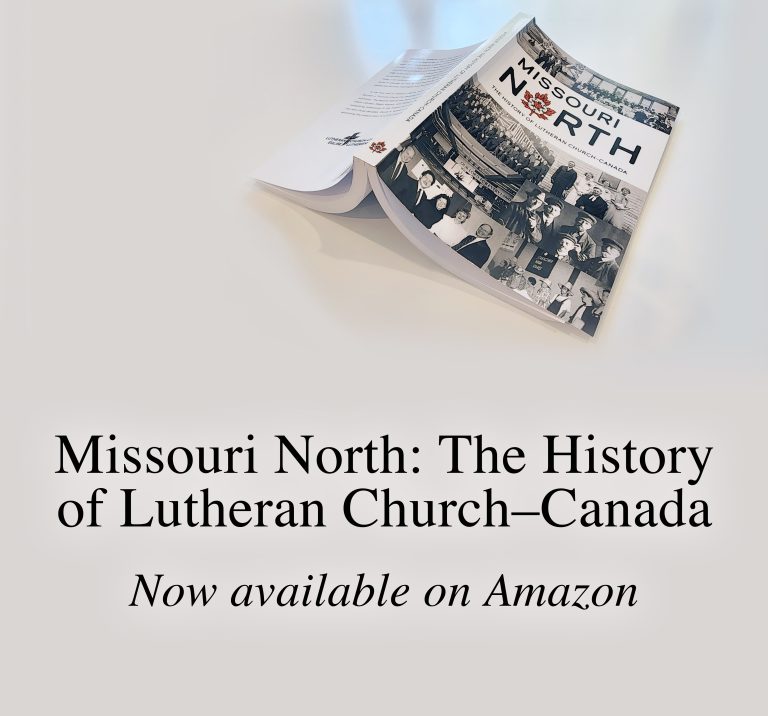How to Train Your Dragon 2: Children’s fantasy, grown-up ideas

by Ted Giese
Building on How to Train Your Dragon’s story of complimentary parts making a whole, and how a change of perspective can improve a person’s overall outlook on life, DreamWorks’ sequel How to Train Your Dragon 2 again focuses on themes of friendship, loyalty, and acceptance.
As in the first film, another big element of this film is family and family life. On the surface this sounds like boilerplate children’s movie material, but it’s good to remember that these themes include a complex series of grown-up concepts and ideas. After all, children’s movies are written by grown-ups. Parents watching How to Train Your Dragon 2 with their children may want to keep this in mind and be careful not to immediately recite the mantra most Hollywood producers want parents to say: “It’s just a kid’s movie.”
In How to Train Your Dragon 2, the idyllic Viking island of Berk is threatened by the mysterious Drago and his rumoured dragon army. Fearing for the island’s safety, Hiccup, the son of the island’s Chief, sets out to try and talk reason into Drago and avert the end of Berk’s now peaceful cohabitation with dragons. Along the way Hiccup is forced to deal with the prospects of leadership and some complex and unexpected family relationships.
Yes, there are dragons—for the most part colourful and fun—and there are more of them than in the first film from 2010. And yes, the computer animation is world class, the voice acting strong, and the pacing is good too. Without any of these technical issues, attention moves easily to the story and its grown-up themes and ideas.
Romance and relationships
The film takes place five years after the first movie, putting the original characters in their late teens to early twenties. This injects the film with the possibility of romance and general interest in grown-up relationships. These range from a traditional boyfriend-girlfriend relationship on the path to an engagement—as seen with the central character of Hiccup and Astrid—to the teenage ‘love-sick” relationships swirling around the character of Ruffnut Thorston, to less traditional relationships.
Ruffnut shows little interest in the devotion and attentions of her male counterparts from the island of Berk, spurning their advances and affections while (and this is intended to be the humorous part) she falls headlong for a minor redeemable villain, Eret son of Eret. Eret is a dragon poacher who works for Drago. This side storyline sticks out for one particular reason: Ruffnut is shown more than once ogling Eret’s muscles as he does ‘masculine’ things like turning cranks and pulling levers. The camera cuts to a first-person slow-motion close-up of what Ruffnut is seeing intercut with her expressions as she gazes at Eret.
If reversed (to a man watching a woman), it’s fair to say this ogling would easily garner the film a different rating. It would be deemed immediately inappropriate for a children’s/family movie to contain a teenage boy ogling isolated body parts of a woman repeatedly in slow-motion close-ups, regardless of whether it’s intended to be humourous or not. Parents need to consider whether humour excuses this sexualization.
The film also contains a brief nod to a non-traditional kind of relationship when the character Gobber, upon watching Hicupp’s mother and father argue with each other, comments “This is why I never got married… That and one other reason.” The throw-away line goes by quickly but parents may want to simply take note and be prepared to talk about this if their children ask, “Why doesn’t Gobber want to marry a girl?” The film’s director and writer Dean DeBlois, who is openly gay, took Ferguson’s ad-libbed line as an indication of Gobber’s sexual orientation and kept it in the film. E! reports DeBlois saying “I love the idea that Gobber is Berk’s resident gay.” Hollywood seems very happy with the inclusion of this grown-up idea added into a children’s film.

Stoick, Hiccup, and Valka
Gobber’s comment comes in a part of the film where Hiccup’s father Stoick is seeing his wife, Valka, again for the first time after 20 years of thinking she was dead. Valka had been carried off by a dragon in a dragon raid on the island of Berk and was presumed killed. More than the brief revelation concerning Gobber, parents may want to consider the complex series of grown-up concepts and ideas brought into film by the addition of Hiccup’s long-lost mother. At this point it will be necessary to spoil a couple of plot points.
Parents may want to consider the complex series of grown-up concepts and ideas brought into film by the addition of Hiccup’s long-lost mother.
The family dynamic between Hiccup and his parents is an area where How to Train Your Dragon 2 cranks up the emotional manipulation. Children whose parents are split up generally go through an intense period of desiring their parents to be together again. They hope the separation, estrangement, or divorce could be whisked away and for things to be the way they were before it all went sour. How to Train Your Dragon 2 provides just such a hoped-for resolution. It’s classic wish fulfillment, and it will hit the secret—or not so secret—desires of many of the film’s viewers.
Twenty years melts away in minutes and they are again one big happy traditional family. Hiccup goes from not knowing his mother was still alive, to accepting her as his mother, to having his parents back together to… what? And this is where the monkey-wrench comes in. Hollywood couldn’t leave this reunited traditional family intact. At the apex of the film’s story Hiccup’s father Stoick sacrifices himself to save his son even though it was his son’s disobedience that brought them to the confrontation which required the sacrifice.
Father and son
Some parting thoughts about the character of Stoick. Unlike King Stephan—the clearly evil father in the recent Disney film Maleficent—Stoick is very concerned and loving towards his son rather than self-centered or stupid. He is dedicated not only to his son but also to the people of Berk whom he governs. Stoick seeks his son out when Hiccup runs off, and he loves his long-lost wife with all his heart. In almost every way, Stoick is a positive father character—surprisingly atypical for a Hollywood film—which makes it all the more puzzling as to why Hiccup is so disobedient. Gone is the movie convention of making the father dimwitted or a jerk, thereby providing a relativistic justification for the child’s disobedience.
As a result, Hiccup, viewed through the lens of his father Stoik, takes on qualities of the Prodigal Son (Luke 15)— but in How to Train Your Dragon 2, Hiccup has no dutiful older brother and his father is dead before they can be entirely reconciled. Of interest is the fact that the film was released on the Father’s Day weekend, adding additional weight to these particular threads within the story, although the impact of Stoick’s death won’t likely be diminished when viewed at a later date.
A children’s movie?
For the last 20 years or so, Hollywood has moved away from producing films aimed solely at children to movies intended for the whole family. As a result, material intended for the grown-ups in the audience has been added. Some believe these additions largely go over the heads of the children viewers, but one has to ask: “Do they really?”
Some believe these grown-up additions largely go over the heads of the children viewers, but one has to ask: “Do they really?”
While it is likely that a large number of young children could miss the implied meaning of Gobber’s brief comment or not understand why Ruffnut is acting so weird around all the men who surround her, it is inconceivable that small children wouldn’t pick up on the relationship between Hiccup’s parents or his relationship to them as individuals. Likewise, the death of a parent in a film like this needs to be discussed with the family afterward, as children watching the movie won’t miss this point.
With the inclusion of grown-up concepts and ideas comes the responsibility to take the opportunity to teach and talk to young viewers about modern ideas of friendship, loyalty, acceptance, and family as compared and contrasted with biblical examples. How to Train Your Dragon 2 is not a shallow film and families planning to see it—or families who have seen it already—need to look past the colourful dragons and talk about the story the film tells and the relationships it depicts.
———————
Rev. Ted Giese is associate pastor at Mount Olive Lutheran Church in Regina. He reviews movies for both The Canadian Lutheran and Issues, Etc.





